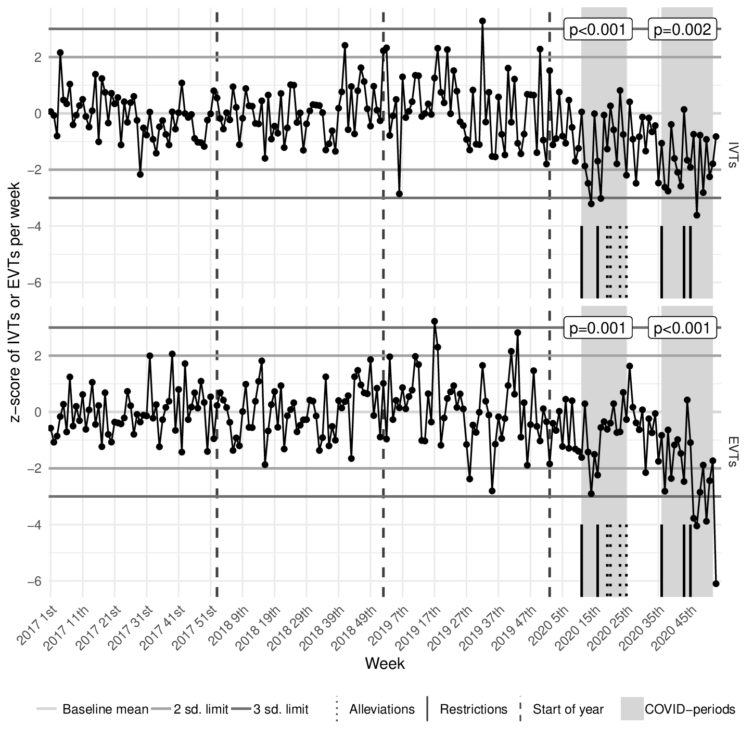Coronavirus disease 2019 (COVID-19) reached Hungary on 4 March 2020 and a week later WHO declared the novel coronavirus outbreak a global pandemic. Cerebrovascular diseases are the second leading cause of death worldwide. Up to 50% of stroke survivors are chronically disabled, which causes a tremendous public health burden with severe economic and social consequences. Over the past decade, the treatment of acute ischemic stroke (IS) has undergone fundamental changes due to the high-quality evidence that shows reperfusion interventions can reduce the risk of death or disability and improve functional outcome.
 “We sought to evaluate and quantify IS care by analyzing the number of IS admissions and reperfusion interventions during the first two waves of the COVID-19 pandemic in Hungary”, summarized dr. Péter Pál Böjti, resident of the Department of Neurology.
“We sought to evaluate and quantify IS care by analyzing the number of IS admissions and reperfusion interventions during the first two waves of the COVID-19 pandemic in Hungary”, summarized dr. Péter Pál Böjti, resident of the Department of Neurology.
A trend analysis was conducted using a new statistical method. Trends and unexpected changes in patient numbers were analyzed using control charts.
A significant decrease was observed in the number of weekly IS admissions and acute treatments (medication and catheter clot removal) during the first and second waves of the coronavirus pandemic. The dynamics of the decline differed for each study metric, with a disproportionately larger decrease in hospital admissions for ischemic stroke compared to acute treatments. Based on some characteristics, the underlying causes are thought to be the impact of changes in population behavior (staying at home for fear of coronavirus infection) and health operational measures (reallocation of hospital capacity and limitation of elective care).
Peter Pal Bojti (János Szentágothai Doctoral School of Neurosciences, Semmelweis University; National Institute of Mental Health, Neurology and Neurosurgery), Geza Szilagyi (János Szentágothai Doctoral School of Neurosciences, Semmelweis University; Department of Neurology, Medical Centre, Hungarian Defence Forces), Balazs Dobi (Department of Probability Theory and Statistics, Eötvös Loránd University; Neuroepidemiology Research Group ELKH, MTA-SE), Istvan Szikora (National Institute of Mental Health, Neurology and Neurosurgery; János Szentágothai Doctoral School of Neurosciences, Semmelweis University; Department of Neurosurgery, Semmelweis University), Balazs Kis (National Institute of Mental Health, Neurology and Neurosurgery), Akos Kornfeld (National Institute of Mental Health, Neurology and Neurosurgery), Csaba Ovary (National Institute of Mental Health, Neurology and Neurosurgery), Lorand Eross (National Institute of Mental Health, Neurology and Neurosurgery; János Szentágothai Doctoral School of Neurosciences, Semmelweis University; Department of Neurosurgery, Semmelweis University), Peter Banczerowski (National Institute of Mental Health, Neurology and Neurosurgery; János Szentágothai Doctoral School of Neurosciences, Semmelweis University; Department of Neurosurgery, Semmelweis University), Wojciech Kuczyński (Department of Sleep Medicine and Metabolic Disorders, Medical University of Lodz), Daniel Bereczki (János Szentágothai Doctoral School of Neurosciences, Semmelweis University; Neuroepidemiology Research Group ELKH, MTA-SE; Department of Neurology, Semmelweis University; European Academy of Neurology, EANcore COVID-19 Task Force)
GeroScience (2021). https://doi.org/10.1007/s11357-021-00424-z


